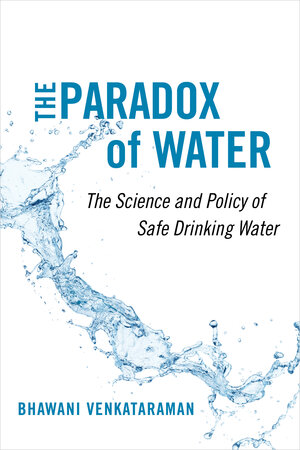By Bhawani Venkataraman, author of The Paradox of Water: The Science and Policy of Safe Drinking Water
Educational literature clearly shows how important it is for students to apply what they are learning in the classroom to “real world” issues. Yet the challenge for many of us instructors in the natural sciences is the dearth of teaching materials and books that help students meaningfully apply scientific concepts and principles with relevant social issues.
This is the situation I found myself in when I began teaching chemistry at Eugene Lang College of Liberal Arts, The New School in New York City. At The New School we encourage students to explore contemporary, social issues through multidisciplinary lenses. The questions I grappled with when I first came to The New School were how can chemistry be taught through socially relevant contexts and how can I help students recognize why a chemical perspective may help inform socially just actions and policies?
As I began developing an introductory undergraduate chemistry course, I realized that the global challenge of access to safe drinking water provided the perfect context. We all have a relationship with water—we know that life requires water. Water evokes cultural and religious sentiments. However, from a public health perspective, it is not just water that humans need, but safe drinking water. Access to safe drinking water allows basic needs to be met, supports educational opportunities for children, helps overcome gender inequities, lowers the stress and anxiety of families, and allows for more socially and economically productive uses of time.
My book, The Paradox of Water: The Science and Policy of Safe Drinking Water, came out of the course I developed connecting the chemistry of water to the social and policy dimensions of access to safe drinking water. In the book, I introduce the underlying chemistry of water that makes it both essential for life and easily susceptible to contamination. I show how this chemistry, in concert with social, economic, and political factors, is crucial to informing drinking water treatments and the regulatory frameworks for the delivery of safe drinking water.
For example, while most people in the global North have access to safe drinking water, this is not necessarily the case in the global South. Why is this? Exploring this question requires an understanding of the chemistry of water and the historic, economic, social, cultural, and political factors, such as the impacts of colonialism. Even in the global North, a substantial minority do not have access to safe drinking water because of the chemistry of water, historic inequities, and regulatory and policy failures. The fact that the drinking water in Flint, Michigan had unsafe levels of lead can be understood at the chemical level by examining why lead leached from the pipes. However, the social reason is a consequence of systemic racism. In the U.S., those most impacted by unsafe water are marginalized, low-socio-economic communities. The chemistry of water makes the delivery of safe drinking water complex and expensive. It demands expertise and is increasingly priced out of reach for some communities.
The history of human civilization is interconnected to access to water sources. As populations rose, so did pollution of water sources, resulting in the rampant spread of diseases. It took an understanding of the science behind why water was responsible for the spread of diseases to develop informed solutions to treat water, resulting in enormous benefits to communities. Using the U.S. as a case study, my book traces the historical development of the infrastructure—scientific, engineering, political, economic, social—necessary for the delivery of safe drinking water from source to tap. I highlight three case studies of water contamination —lead, nitrate, PFAS— that resulted in tragic social and economic consequences for communities when policymakers disregarded water’s chemical behavior. These cases show how drinking water management must be strengthened.
The inherent chemistry of water that makes it essential for life and easily contaminated also demonstrates the role of the precautionary principle. I illustrate applications of this principle through climate-resilient solutions for drinking water management, including nature-based approaches and potable reuse systems. My book discusses the science, policy, and benefits of these approaches, as well as challenges that should inform additional research and shape how these approaches can be implemented in just and equitable ways. Cutting across scales—from large infrastructure to rural, point-of-service approaches, the book presents decentralized, appropriate drinking water treatments for rural communities. I discuss the benefits and complexities faced by communities where these decentralized approaches tend to be implemented and argue that governments must invest in delivery of safe drinking water, respecting the right for safe drinking water for all.
My book ends by emphasizing the importance of an informed public. The more we understand the significance of safe drinking water to our health and wellbeing, the more effective our demands for sound and just actions by our political representatives will be.
As an educator, I’ve seen how teaching about water in this way gives students a deep respect for the molecular properties of water that allow for our existence as well as the crucial role of safe drinking water for a healthy community. I aim to help students understand why the chemistry of water placed within social, political, cultural, and economic perspectives must inform policies and actions to ensure that every person benefits from sustainable, equitable access to safe drinking water.

